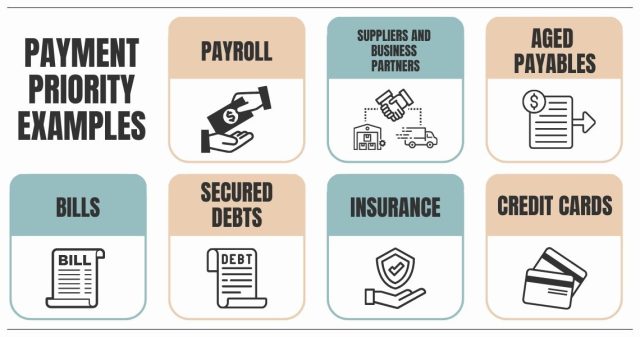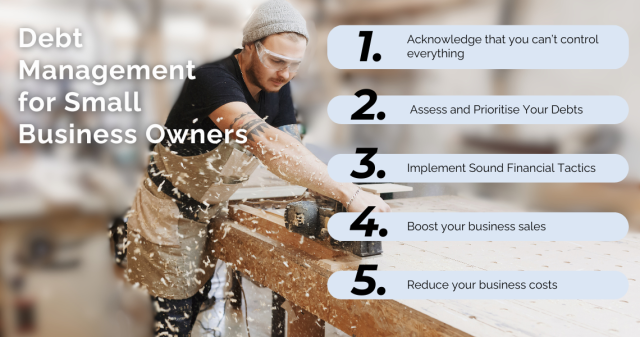



Book a Free Consultation!
✅Builders CFO Program
✅Business Improvement Program
✅Taxation Advice


As a small business owner, your venture is the result of passion, risk-taking, and hard work. While building something from scratch is exciting, there’s also the unsettling reality of accumulating debt. If not managed properly, this debt can become a burden on what you’ve worked so hard to achieve. But don’t worry, proactive debt management is not just about numbers; it’s a strategic game plan that involves understanding your financial situation and taking decisive steps to regain control.
Debt is not something you can’t overcome. It’s a challenge that, when tackled head-on, can actually drive transformative growth for your business. In this guide, we’ll share five actionable steps that small business owners can take to navigate debt and come out stronger in the end.
Step 1: Acknowledge that you can’t control everything
Running a small business comes with its fair share of risks. You can’t always predict recessions or natural disasters, but being overly cautious won’t lead to success either. However, it’s important to be realistic about your small business and stay aware of potential risks, this includes understanding your breakeven point and how long you can survive or are willing to go under your breakeven point before it becomes too difficult to regain control.
Be aware of the trends and developments in your industry. If you start feeling like your debt is getting out of control, it’s best to take action right away. Sometimes this may mean letting a team member go at the benefit of saving the business. Take control of the situation and make sure to keep a close eye on your small business’s financial health and don’t go it alone.
Step 2: Assess and Prioritise Your Debts
Not all debts are the same, and it’s important to consider this when deciding how to handle them. To effectively prioritise, start by creating a detailed list of your financial obligations and categorise them based on their impact. Here’s how you can get started:
- Immediate Obligations: These include employee wages and taxes – non-compliance can lead to penalties and tarnish your business’s reputation.
- Operational Necessities: Keeping the lights on through utilities, rent, and supplier dues is crucial for your daily operations.
- Long-Term Debt: This typically includes loans and credit facilities. While these may not have immediate repercussions, neglecting them can compound interest and damage creditworthiness.
For most businesses in Australia, the top priority is clear: the Australian Taxation Office (ATO). To address any tax debt owed, contact the ATO and discuss a payment plan. It’s advisable to do this before the bill is due. The ATO understands that businesses can face financial difficulties due to challenging economic conditions or unexpected events. While they should be taken seriously, ATO representatives are sympathetic to such situations.
To help manage tax debt, the ATO offers tailored assistance and payment plans, sometimes with reduced interest. They take your personal circumstances into account to ensure you can meet your obligations. If you’re a sole trader with a tax debt of less than $100,000, you can set up a payment plan directly through the ATO’s online service at www.ato.gov.au/businessdebt.


- Payroll: If you don’t pay your employees’ wages on time, you may be penalised. You may be able to renegotiate contracts with some staff but bear in mind that’s likely to affect their morale. Some may quit.
- Suppliers and business partners: Avoid losing valuable goodwill with your most loyal suppliers and business partners. In some cases, you may have an opportunity to speak to suppliers and business partners and agree on beneficial terms that can assist you and ensure all parties are paid.
- Aged payables (60 days or more): If you don’t pay, your credit score may be impacted, which will affect your ability to borrow money in the future.
- Bills: Outgoing costs such as rent and utility bills need to be paid to keep the lights on! And again, not paying these could affect your credit rating.
- Secured debts: If you run your small business as a sole proprietor or partnership, you might be held personally liable for debts, and creditors could try to take your assets. Work hard to head off that eventuality.
- Insurance: This is not the time to skimp on protections, especially professional indemnity and public liability cover.
- Credit cards: There’s a reason the product descriptions for credit cards are so long: there are all sorts of penalties and charges that can pile up quickly … and that’s on top of the interest.
Step 3: Implement Sound Financial Tactics
With the battleground now in clear view, it’s time to implement strategies that reposition your business’s financial stance. This could include:
- Renegotiation: Engage in conversations with your creditors. Be transparent about your financial standing and propose new terms that are sustainable for your business.
- Refinancing and Consolidation: Explore options to restructure existing loans with more favourable terms, such as lower interest rates and longer payback periods.
- Business Boosting Initiatives: Think innovatively about your business model, product offerings, and sales channels. By increasing revenue streams, you not only offset existing debt but also future-proof your operations.
- Cost Cutting: Every cent saved is a cent that can be directed towards alleviating your debt burden. This could involve a serious reevaluation of business expenditures, from operational costs to discretionary spending.
Each of these tactics may require different skill sets and negotiations, but each can play a pivotal role in transitioning your business from a position of distress to stability.
Furthermore, it’s important to set key milestones and plan what triggers an event for example with costs cutting this may not be implemented immediately, you may have an advertising campaign not returning an investment so you may set a 3 month period for this campaign to provide a return before cutting the cost.
Step 4: Boost your business sales
A surefire way to help avoid debt is to boost your sales to bring in more income. You could try taking actions such as:
- offering a sale or discounts for your services/products
- adapting your business model
- offering a new range of products
- expand into different markets
- Advising your current contacts and customers of a new service
To ease the debt burden, increasing your income is crucial. Leave no stone unturned when it comes to generating income and controlling your costs.
Additionally, ensure your accounts receivable systems are optimised. Implement prompt follow-ups for late payments and offer upfront payment discounts to enhance cash flow.
Step 5: Reduce your business costs
You should also look at areas where you could cut business costs, for example:
- Do you really need to rent an office/factory or can you operate from home?
- Think about your wages bill: can you cut down on staff?
- Review your operational expenses (which you should be doing regularly anyway) and see if there are savings you can make.
- Try negotiating with your existing suppliers for a discount, or using new ones.
By reaching out to all your creditors and genuinely explaining the situation, you may be able to negotiate better terms. Approach them with a comprehensive plan for resolving your debt situation and maintain a positive attitude (ATO Included). Let them know your intention to pay in full but that you need to renegotiate terms to make it possible.
You may find that creditors understand it’s in their best interest to accommodate your request. After all, if your business fails, they won’t receive anything in return. By taking a proactive approach and reaching out to your creditors before they start pursuing you for missed payments, they are more likely to take you seriously and agree to your terms.
With the creditors placated, you’ll find that cutting costs may be the fastest way to increase your cash flow and chip away at your liability. This is something to do before resorting to drastic debt-reduction measures. You want to make sure you don’t cut back too much, because you don’t want to destroy your business in the process of paying off its debts. After all, closing the business down will leave you with no income at all, which is definitely not going to help the matter.


Take control of your debt and thrive
Regardless of the challenges, it’s crucial to promptly address and resolve business debts. Debt doesn’t disappear overnight – but don’t worry, we’re here to help you regain control and explore all available options. Winning this battle is often a step-by-step process, a true test of perseverance.
Being in debt can be daunting, but letting it spiral out of control is even worse. So, reach out to us for expert guidance and support in overcoming your business debt and setting yourself up for a brighter future. Together, let’s pave the way to financial freedom.

Send To Someone